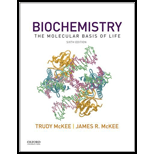
Concept explainers
To review:
The better reducing agent ineach of the given pairs:
NADH/H2O
UQH2/FADH2
Cyt c (reduced)/Cyt b (reduced)
FADH2/ NADH
NADH/ FMNH2
Introduction:
Reduction is a process of the gain of H+ (hydrogen ions) or the loss of O (oxygen), whileoxidation is a process of the gain of oxygen or the loss of hydrogen. Oxidizing agents add an oxygen to another substance or remove a hydrogen from a substance. Reducing agent, sn the other hand, either add a hydrogen or remove an oxygen from a compound.
Explanation of Solution
Better reducing agents out of the mentioned substances in the given pairs of compounds are discussed below:
NADH/H2O: NADH (reduced Nicotinamide adenine dinucleotide)is a better reducing agent because water molecule is considered weak as both, oxidizing as well as reducing agent, as it can reduce only a limited number of substances, whereas NADH can reduce a variety of substances. Moreover, the redox potential of NADH is lower as compared to the water molecules.
UQH2/FADH2: UQH2(Ubiquinol-10-reduced) is a better reducing agent because it can easily propagate electrons from complex I. Moreover, its redox potential is significantly lower than the FADH2 moiety.
Cyt c (reduced)/Cyt b (reduced): Cyt b (Cytochrome b), in its reduced form, is a better reducing agent because it can easily liberate electrons to reduce cytochrome a and has a much lower reduction potential than Cyt c.
FADH2/NADH: NADH (Nicotinamide adenine dinucleotide) is a better reducing agent than FADH2 (Flavin adenine dinucleotide) because of its lower reduction potential value and the ability to easily liberate electrons.
NADH/FMNH2: FMNH2 (flavin mononucleotide) is a better reducing agent than NADH ((Nicotinamide adenine dinucleotide) because of the fact that it can easily donate electrons and has a considerably lower reduction potential.
Therefore, it can be concluded that the ability to act as a reducing agent depends on the intricate reduction potential of a chemical species. In case a chemical species has a high reduction potential, it has a strong affinity for electrons, while a low reduction potential facilitates easy liberation of electrons. The liberated electrons can be used to reduce other molecules and therefore, a low reduction potential value confers higher reducing capabilities.
Want to see more full solutions like this?
Chapter 10 Solutions
Biochemistry: The Molecular Basis of Life
- Br Mg, ether 1. HCHO (formaldehyde) 2. H+, H₂O PCC 1. NH3, HCN ? (pyridinium chlorochromate) 2. H2O, HCI 11. Which one of the following compounds is the major organic product of the series of reactions shown above? Ph. Ph. OH NH2₂ A Ph. Ή NH2 B OH Ph Η Ph OH NH2 NH2₂ NH₂ C D Earrow_forwardB A 6. Which ONE of the labeled bonds in the tripeptide on the right is a peptide bond: H₂N N 'N' OH C H A, B, C, D or E? HN E OHarrow_forwardQuestions 8-9 are 0.4 points each. The next two questions relate to the peptide whose structure is shown here. To answer these questions, you should look at a table of H2N/.. amino acid structures. You don't have to memorize the structures of the amino acids. IZ 8. What is the N-terminal amino acid of this peptide? A) proline B) aspartic acid C) threonine 9. What is the C-terminal amino acid of this peptide? A) proline B) aspartic acid C) threonine N OH D) valine E) leucine D) valine E) leucine NH "OH OHarrow_forward
- 7. What is the correct name of the following tripeptide? A) Ile-Met-Ser B) Leu-Cys-Thr C) Val-Cys-Ser D) Ser-Cys-Leu E) Leu-Cys-Ser H₂N!!!!! N H ΖΙ .SH SF H IN OH OHarrow_forwardPlease draw out the following metabolic pathways: (Metabolic Map) Mitochondrion: TCA Cycle & GNG, Electron Transport, ATP Synthase, Lipolysis, Shuttle Systems Cytoplasm: Glycolysis & GNG, PPP (Pentose Phosphate Pathway), Glycogen, Lipogenesis, Transporters and Amino Acids Control: Cori/ Glc-Ala cycles, Insulin/Glucagon Reg, Local/Long Distance Regulation, Pools Used Correctlyarrow_forwardPlease help provide me an insight of what to draw for the following metabolic pathways: (Metabolic Map) Mitochondrion: TCA Cycle & GNG, Electron Transport, ATP Synthase, Lipolysis, Shuttle Systems Cytoplasm: Glycolysis & GNG, PPP (Pentose Phosphate Pathway), Glycogen, Lipogenesis, Transporters and Amino Acids Control: Cori/ Glc-Ala cycles, Insulin/Glucagon Reg, Local/Long Distance Regulation, Pools Used Correctlyarrow_forward
- f. The genetic code is given below, along with a short strand of template DNA. Write the protein segment that would form from this DNA. 5'-A-T-G-G-C-T-A-G-G-T-A-A-C-C-T-G-C-A-T-T-A-G-3' Table 4.5 The genetic code First Position Second Position (5' end) U C A G Third Position (3' end) Phe Ser Tyr Cys U Phe Ser Tyr Cys Leu Ser Stop Stop Leu Ser Stop Trp UCAG Leu Pro His Arg His Arg C Leu Pro Gln Arg Pro Leu Gin Arg Pro Leu Ser Asn Thr lle Ser Asn Thr lle Arg A Thr Lys UCAG UCAC G lle Arg Thr Lys Met Gly Asp Ala Val Gly Asp Ala Val Gly G Glu Ala UCAC Val Gly Glu Ala Val Note: This table identifies the amino acid encoded by each triplet. For example, the codon 5'-AUG-3' on mRNA specifies methionine, whereas CAU specifies histidine. UAA, UAG, and UGA are termination signals. AUG is part of the initiation signal, in addition to coding for internal methionine residues. Table 4.5 Biochemistry, Seventh Edition 2012 W. H. Freeman and Company B eviation: does it play abbreviation:arrow_forwardAnswer all of the questions please draw structures for major productarrow_forwardfor glycolysis and the citric acid cycle below, show where ATP, NADH and FADH are used or formed. Show on the diagram the points where at least three other metabolic pathways intersect with these two.arrow_forward
 Concepts of BiologyBiologyISBN:9781938168116Author:Samantha Fowler, Rebecca Roush, James WisePublisher:OpenStax College
Concepts of BiologyBiologyISBN:9781938168116Author:Samantha Fowler, Rebecca Roush, James WisePublisher:OpenStax College BiochemistryBiochemistryISBN:9781305577206Author:Reginald H. Garrett, Charles M. GrishamPublisher:Cengage LearningBasic Clinical Lab Competencies for Respiratory C...NursingISBN:9781285244662Author:WhitePublisher:Cengage
BiochemistryBiochemistryISBN:9781305577206Author:Reginald H. Garrett, Charles M. GrishamPublisher:Cengage LearningBasic Clinical Lab Competencies for Respiratory C...NursingISBN:9781285244662Author:WhitePublisher:Cengage





